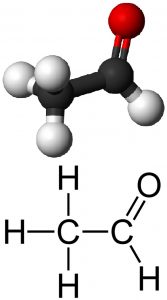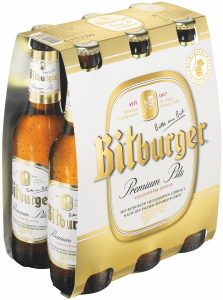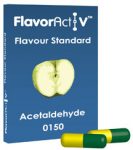Author: Malcolm Frazer
Along the delightful path from sugar to ethanol, yeast creates many intermediate compounds, some of which go on to metabolize into various other compounds, while others are utilized by the yeast to complete fermentation or store energy for survival once the current sugar source is depleted. A portion of these intermediate compounds are inevitably left behind despite our unicellular friends’  best efforts, and to a degree, they help make up the profile of a beer. Whether or not these residual compounds are considered complimentary or an off-flavor often comes down to what the brewer prefers for their final product. Unlike diacetyl, which is acceptable and even preferred to some degree in certain beer styles, perceptible levels of acetaldehyde (C2H4O or CH3CHO) is viewed by most as undesirable on a fairly universal scale.
best efforts, and to a degree, they help make up the profile of a beer. Whether or not these residual compounds are considered complimentary or an off-flavor often comes down to what the brewer prefers for their final product. Unlike diacetyl, which is acceptable and even preferred to some degree in certain beer styles, perceptible levels of acetaldehyde (C2H4O or CH3CHO) is viewed by most as undesirable on a fairly universal scale.
Acetaldehyde (ass-eh-tal-deh-hyde) is an organic compound in the aldehyde family that’s common in trace amounts not only in beer, but also coffee, certain ripe fruits, and wine. Throughout my journey in beer, I’ve found people tend to experience acetaldehyde differently with most saying it has a pungent green apple character akin to green Jolly Ranchers, though it also yields descriptive terms including latex paint, raw pumpkin, and bug spray or citronella. To me, acetaldehyde is very off putting, at least when I’ve tasted beer I thought I perceived it in, but who’s to say I wasn’t picking up something else?
Curious about the ability of tasters to detect and identify acetaldehyde, we designed this xBmt in collaboration with makers of high quality off-flavor capsules, FlavorActiV, in order to evaluate it for ourselves.
| PURPOSE |
To evaluate the ability of blind tasters to distinguish between a pale lager dosed with acetaldehyde from an unadulterated sample of the same beer.
| METHODS |
I received various FlavorActiV flavor standards in the mail from Marshall, all of which had the labels removed and had a name written on the package for identification. The primary reason for doing this was to keep me blind to the off-flavor for my own trials.
In keeping with prior xBmts in this off-flavor series, I opted to use Bitburger German Pilsner due to its clean ester profile,  firm maltiness, and moderate bitterness that I figured would allow the adulterant to shine. I considered using a prototypical American Light Lager but was dissuaded by a distinctive apple or pear-like sweetness some perceive in them, I didn’t want that getting in the way of the off-flavor.
firm maltiness, and moderate bitterness that I figured would allow the adulterant to shine. I considered using a prototypical American Light Lager but was dissuaded by a distinctive apple or pear-like sweetness some perceive in them, I didn’t want that getting in the way of the off-flavor.
The accepted flavor threshold for acetaldehyde is 5-15 parts per million (ppm) with most commercial beers clocking in at levels around 2-4 ppm, present but not detectable. Unable to find any data on acetaldehyde levels in Bitburger, I was forced to trust it was close to absent based both on my perception and the fact it’s generally lauded as a clean German Pils.
 Each acetaldehyde capsule provided by FlavorActiV is designed to impart 3 times the flavor threshold when added to 1 liter of beer, a concentration we determined would be ideal for testing such a commonly cited off-flavor. To prepare the dosed sample, I followed the instructions provided by FlavorActiv by first gently pouring about 200 mL of beer into a standard 4 liter pitcher, adding the contents of 2 flavor standard capsules, gently swirling, then adding an additional 1800 mL of beer to the vessel. The non-dosed samples were treated similarly to ensure no differences caused by anything other than the off-flavor.
Each acetaldehyde capsule provided by FlavorActiV is designed to impart 3 times the flavor threshold when added to 1 liter of beer, a concentration we determined would be ideal for testing such a commonly cited off-flavor. To prepare the dosed sample, I followed the instructions provided by FlavorActiv by first gently pouring about 200 mL of beer into a standard 4 liter pitcher, adding the contents of 2 flavor standard capsules, gently swirling, then adding an additional 1800 mL of beer to the vessel. The non-dosed samples were treated similarly to ensure no differences caused by anything other than the off-flavor.
| RESULTS |
Data for this xBmt was collected during a TRASH Homebrewers meeting being held at Apis Mead & Winery. In total, 22 people with varying levels of experience, all blind to the variable, were served 1 sample of the beer intentionally dosed with acetaldehyde flavor standard and 2 samples of the clean beer in different colored opaque cups then instructed to select the unique sample. In order to reach statistical significance, 12 tasters (p<0.05) would have had to select the dosed sample, though 15 (p=0.0009) accurately identified the unique sample, suggesting participants were able to reliably distinguish a beer intentionally dosed with acetaldehyde from a clean sample of the same beer.
Those participants who correctly selected the acetaldehyde beer as being different were instructed to complete a brief set of additional questions comparing only the two different beers, still blind to the nature of the xBmt.
When the 15 tasters who correctly identified the unique sample on the triangle test were asked about preference, 11 chose the non-dosed sample and 4 reported having no preference despite noticing a difference. Not a single taster endorsed the beer dosed with acetaldehyde as the one they preferred.
It was then revealed to participants that one of the samples had been dosed with an off-flavor, though they were not informed which off-flavor was used. When asked to identify the beer they believed was dosed with an off-flavor, all 15 tasters made the correct selection. Next, tasters were provided a list of common off-flavors that included brief descriptions of how they typically present in beer and asked to select the one they believed the beer was dosed with. Acetaldehyde received a plurality of the votes with 6 tasters correctly selecting it while 3 believed it was DMS, 2 chose astringent, 2 thought it was metallic, 1 selected butyric, and 1 felt the beer was dosed with oxidized flavor standard.
My Impressions: Since I was unaware of the particular off-flavor being used for this xBmt, my trials were more blind than usual. While not as obvious as I imagined given the concentration in the beer, I was able to consistently identify the unique sample over four triangle tests. To me, the dosed beer had a different mouthfeel than the clean samples, which is what led me to initially believe astringency was the off-flavor used in this xBmt. However, returning to the beers a bit later, still unaware of what the off-flavor was, I detected an aroma akin to bug spray that made me second guess myself, as this was something I knew to be associated with acetaldehyde.
| DISCUSSION |
With descriptors like green apple, latex, and bug spray combined with a relatively low flavor threshold, it’s not surprising participants were able to reliably distinguish a beer intentionally dosed with acetaldehyde to 3 times the threshold from non-dosed samples. Combined with the fact 6 of the 15 tasters who were correct on the triangle test accurately identified the off-flavor, these results support the notion that, at least in higher concentrations, acetaldehyde is both detectable and identifiable.
As a Nationally ranked BJCP judge who values the evaluative side of brewing and beer, I was pleased with these results and felt validated to some degree. That said, knowing that the adulterated sample was dosed to 3 times the flavor threshold left me wondering what the actual concentration is in the beers homebrewers make that get dinged for having acetaldehyde. Since judging is done by fallible human beings, I’ve little doubt acetaldehyde is occasionally mistaken for other flavors, though it seems it may not be as good at hiding itself in beer as other commonly cited off-flavors.
If you’ve ever experienced an acetaldehyde dosed beer or if you think you’ve had a beer with noticeable amounts of acetaldehyde, please share your thoughts in the comments section below!
Support Brülosophy In Style!
All designs are available in various colors and sizes on Amazon!
Follow Brülosophy on:
FACEBOOK | TWITTER | INSTAGRAM
If you enjoy this stuff and feel compelled to support Brulosophy.com, please check out the Support Us page for details on how you can very easily do so. Thanks!












11 thoughts on “exBEERiment | FlavorActiV Off-Flavor Series: Acetaldehyde In A Pale Lager”
“To evaluate the ability of blind tasters to distinguish between a pale lager dosed with DMS from an unadulterated sample of the same beer.”
You’ve probably meant acetaldehyde 😉
Excellent article! I love that you’re blind to the off flavor until the very end.
Nice article.
Small mistake, I think that “DMS” should be replaced in this sentence: “To evaluate the ability of blind tasters to distinguish between a pale lager dosed with DMS from an unadulterated sample of the same beer.”
Yes! Purpose should have been “acetaldehyde” vs DMS. Fixed! Thanks.
*Cut & paste…FTL? (For The Loss)*
Your Purpose statement says DMS, not acetaldehyde. Is this an error?
Yes. Fixed. See above. Thanks so much.
I worked on a startup for a major brewery, and one of the issues was that the oxygenation stones somehow were inserted pointing in the wrong direction, and the result was that “acetaldehyde was sky-high” in the post-ferment samples (due to insufficient oxygen). That kind of contradicts some of the oxygenation/aeration exbeeriments. Of course, in large commercial breweries there is a time factor as well as different size aspects.
Acetalhyde is pretty horrible. I’m not surprised it’s been confused with astringent, oxydised or metallic. I find it a fairly sharp feel reminiscent of ammonia or white spirit. I’ve not really found it in many beers (maybe some old-ish casks?!), but definitively in home-brewed fruit wines (a mate used to ferment marrows in a bucket in the kitchen, that definitively had plenty at times). Also in some cheap red wines.
Cask ale that’s been on air too long is a classic place to find acetaldehyde!
This is really cool and got me thinking I’d like to try these and see if I can identify off flavors. Then I realized how stupid expensive these capsules are!!! Any thought to doing “homemade” off flavor tests like the one here?:
http://barlowbrewing.com/2010/10/14/how-to-do-your-own-off-flavor-beer-tasting/
I realize this is several years old but I ended
up here after googling “bitburger acetaldehyde.” I just cracked a 500 mL can of the German pils and got a subtle green apple aroma, and a little in the flavor. Not offensive at all, but noticeable. I’m not totally sure it’s acetalaldehyde but seems like it could be. If not, I think there is a red apple ester that I might be sensitive to, it shows up in a lot of saisons I find.